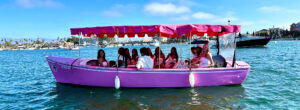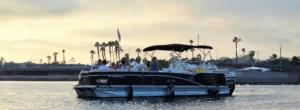Introduction
Newport Harbor is a prime destination for boating enthusiasts, offering scenic views, calm waters, and a variety of boating experiences. However, like any coastal area, Newport Harbor is affected by the natural ebb and flow of tides. Understanding how tides impact boating is essential for a safe and enjoyable experience. Tides can influence everything from water depth to navigational routes, making it crucial for boaters to be aware of tidal patterns before heading out.
This article explores the impact of tides on boating in Newport Harbor, covering essential topics like tidal changes, safety considerations, and tips for navigating tidal shifts. Whether you’re a seasoned sailor or a first-time boater, understanding tides can enhance your overall boating experience.
Understanding Tides
**Tides** are the regular rise and fall of sea levels caused by the gravitational pull of the moon and the sun. In Newport Harbor, as in most coastal areas, there are typically two high tides and two low tides each day, known as **semi-diurnal tides**. The timing and height of these tides can vary depending on the position of the moon, weather conditions, and other factors.
Tides are categorized into **spring tides** and **neap tides**. Spring tides occur during the full moon and new moon phases, resulting in higher high tides and lower low tides. Neap tides, which occur during the quarter moon phases, lead to less extreme tidal fluctuations. Boaters in Newport Harbor need to understand these tidal cycles, as they can significantly impact water conditions and navigational routes.
Tip: Check local tide charts before heading out, as they provide detailed information about the expected tidal changes throughout the day, helping you plan your trip more effectively.
How Tides Affect Water Depth
One of the most significant impacts of tides on boating in Newport Harbor is the change in **water depth**. During high tide, water levels rise, providing more clearance for boats, especially in shallow areas. This makes it easier for larger boats to navigate through narrow channels or near sandbars. Conversely, low tides can reduce water depth, making certain areas of the harbor more challenging to navigate.
At low tide, boaters need to be cautious of exposed rocks, mudflats, or sandbars, as these can pose hazards to boats with deeper drafts. In extreme low tide conditions, some parts of Newport Harbor may become inaccessible for larger vessels, while smaller boats may still be able to pass through with caution.
Tip: Use depth sounders or GPS devices equipped with tide information to monitor water depth and avoid potential grounding during low tides.
Navigational Challenges During Tidal Changes
Tidal changes can create **navigational challenges** in Newport Harbor, particularly for inexperienced boaters. As the tide rises or falls, the flow of water through channels and inlets can become stronger, affecting boat handling and maneuverability. Strong tidal currents can make it difficult to maintain a steady course, especially in narrow passages or when docking.
During outgoing tides (ebb tides), the current flows toward the ocean, potentially increasing the speed of boats heading seaward but making it more challenging for boats returning to harbor. Incoming tides (flood tides) have the opposite effect, helping boats enter the harbor more easily but slowing down those heading out to sea.
Tip: Pay attention to current speed and direction when navigating tidal waters. Adjust your throttle and steering to maintain control and stability.
Tides and Boating Safety
Boating safety is closely linked to understanding and respecting tides. Low tides can expose hidden obstacles like rocks or debris, increasing the risk of grounding or hull damage. It’s essential to reduce speed and stay alert when navigating in areas prone to low water levels. Additionally, high tides can bring stronger currents, which may affect docking and anchoring, especially for smaller boats.
Anchoring during tidal changes requires special attention. As the water level rises or falls, the tension on the anchor line can change, potentially causing the anchor to drag or the boat to swing unexpectedly. Boaters should ensure their anchor line is long enough to accommodate tidal fluctuations, providing a secure hold even as the tide changes.
Tip: Always wear a life jacket and have safety equipment on board, as changing tides can lead to unpredictable water conditions.
Docking and Tides
Docking in Newport Harbor requires consideration of tidal movements. At high tide, docks may be at an elevated position, making it easier to tie up your boat. However, strong tidal currents can create challenges when approaching the dock, requiring precise control and maneuvering. Low tides can have the opposite effect, lowering the dock and making boarding or disembarking more difficult.
When docking at a floating dock, the structure rises and falls with the tide, making it more adaptable to tidal changes. However, fixed docks remain at a constant height, which can cause difficulties during extreme tidal conditions. Boaters should use long, adjustable dock lines to accommodate the rise and fall of tides, preventing boats from becoming stuck or damaged.
Tip: Approach docks slowly and at an angle, allowing for better control and adjustments as the tide impacts your boat’s position.
Anchoring Considerations
Anchoring in tidal waters like Newport Harbor requires a solid understanding of **tide changes**. As tides rise and fall, the position of the anchored boat can shift, which can lead to unexpected movements or even collisions with nearby vessels. To avoid these risks, boaters should use enough anchor line (scope) to accommodate tidal fluctuations. A general rule of thumb is to use at least **seven times** the water depth in anchor line length to ensure a secure hold.
In addition, boaters should be aware of the changing depth as the tide comes in or goes out. A shallow anchoring spot at high tide may become too shallow at low tide, risking grounding. It’s also important to check that the anchor is set properly to prevent it from dragging as the tide changes direction.
Tip: Use a tidal app or chart plotter to monitor the tide’s progression, ensuring safe anchoring throughout your stay.
Timing Your Trip with the Tides
Timing your boating trip according to the tides can make for a smoother and more enjoyable experience in Newport Harbor. High tides are often the best time to navigate the harbor, as water levels are higher, providing more clearance in shallow areas. Boaters should plan their departure and return times to coincide with rising tides for easier navigation.
Low tides, while navigable, may present more challenges, such as shallow areas, exposed rocks, and stronger currents in some channels. Planning your trip with an awareness of the tidal schedule can help you avoid potential hazards and ensure a safer trip.
Tip: Use tide charts and apps to plan your boating trip. It’s always better to err on the side of caution and adjust your plans based on changing tidal conditions.
Impact of Weather on Tides
Weather conditions can also influence tides in Newport Harbor. Strong winds, especially during storms, can cause tidal surges or unusually low tides, making boating more unpredictable. High winds pushing water toward the shore can lead to higher-than-expected tides, while offshore winds can cause tides to be lower than forecasted.
Heavy rainfall can also impact tidal conditions by increasing the volume of freshwater entering the harbor. This can affect water levels and currents, especially near inlets and estuaries. Boaters should be prepared for sudden changes in water levels during stormy weather, taking extra precautions to secure the boat and maintain stability.
Tip: Keep an eye on weather forecasts and be prepared to adjust your plans if storm conditions are expected to affect tides and water levels.
Environmental Impact of Tides
Tides play an essential role in the **environmental health** of Newport Harbor. They help circulate nutrients, support marine life, and flush out debris from the harbor. However, tides can also bring in debris and pollutants from surrounding areas, impacting water quality. Boaters should be mindful of their environmental footprint, especially during low tide when trash and debris may be more visible.
It’s important for boaters to practice **clean boating**, such as properly disposing of trash, using eco-friendly cleaning products, and preventing fuel spills. By respecting the tidal environment, boaters can contribute to a healthier harbor ecosystem.
Tip: Participate in local harbor clean-up efforts to help maintain the beauty and health of Newport Harbor for everyone to enjoy.
Conclusion
Tides have a significant impact on boating in Newport Harbor, influencing everything from water depth and navigational routes to safety and environmental health. Understanding tidal changes and planning your trip accordingly can enhance your boating experience and help ensure safety on the water. By taking into account factors like water depth, anchoring, docking, and weather, boaters can navigate Newport Harbor confidently and enjoy all that it has to offer.
So, before you set sail, be sure to check the tide charts, plan ahead, and embrace the natural ebb and flow of the tides for a successful day on the water!
Excited for an adventure with us or have a question? Call us at: (949) 675-8433 Book Your Ride with us: Click here to Book


